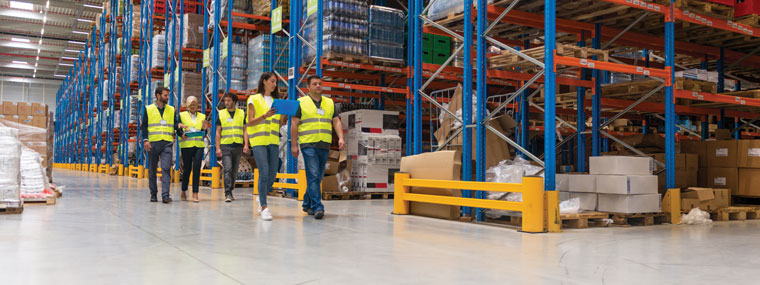
State of the Supply Chain—Update Mid-2022
By Diane M. Calabrese / Published August 2022

Weak. Broken. Or somewhere in between…
We don’t need metaphors to tell us that supply chains have become less than reliable. Perspective always helps in a tough situation. And here?
Yes and no. Disruptions of a memorable sort have happened, but the one being experienced now is unique.
“These last two years are still unprecedented,” says Curtis Braber, owner of BE Power Equipment in Abbotsford, BC, Canada. “Even in Vancouver, where dock strikes have thrown things off from time to time…”
None of the past disruptions equate with those spawned by the pandemic, explains Braber. “It started with a lot of small components.”
That got worked out, says Braber. “Then, it shifted to big components.” In the current state “inconsistent delivery of engines” is one big issue. Braber can get engines; but getting the precise engines his customers want is the goal, and it’s not easy.
“Just the sheer amount of time people like [us] are spending on the supply chain is a new factor in business,” says Braber. “Two times as many people have to work twice as hard to move containers.”
One thing that has helped Braber’s company is its measured embrace of lean manufacturing principles. “At our company we run lean, but I’ve never been a believer in just-in-time. It seemed risky.”
And so Braber proceeded with “caution” in adopting the method that would have meant low reserves of components. That gave an assist to his company as chains frayed. In fact, even before supply chain issues arose in 2020, his company was committed to diversifying its vendor sources.
Adjust. Adapt. That’s what members of our industry do when the variables change. In the mid- and late-1980s the economic climate in the United States and elsewhere included some torrid interest rates. The cost of credit did not curtail business like a missing part can, but it did demand attention.
Jack Hill, executive director of sales, marketing, quality, and service at General Pump, a member of the Interpump Group, headquartered in Mendota Heights, MN, got started in the industry during volatile economic years. Perhaps he gets at least part of his positive outlook from knowing that this, too, will pass.
Supply chain disruptions, like other issues, arise. And they must be circumvented. “We are all living in a very unusual business environment,” says Hill. “Coming back from COVID-19 restrictions to the major increase in demand for pretty much everything has caused us all difficulties in the supply chain process.”
Over a long trend line, Hill does not view the current supply chain as less reliable in the whole. The idea is to look ahead to identify the weak link(s) and fix it (them).
And fraying could be anywhere. “Not enough container ships, not enough shipyard workers, then not enough truck drivers etc., and these issues all lead to extended delays,” says Hill.
Can do. Will do. That’s the attitude bolstering members of our industry.
Rethink is also in the mix. Brad Howland, president of Easy-Kleen in Sussex Corner, NB, Canada, counts himself among those who have reevaluated just-in-time processes.
“Generally, components in our industry have been readily available, and production quantities could be predicted from the experience of knowing the factories—and that is gone,” says Howland. “Now, we are faced with the need to rethink everything each time.”
Howland sums it up this way: “Just-in-time is no longer an option.”
Among the supply chain issues, Howland singles out container shipping as particularly difficult. “The cost and inconsistency of container shipping have been two of the hardest things to navigate. Even if we can find the materials we need to order, getting them here is another issue.”
And in Howland’s lexicon, is there a working definition of a fully functioning supply chain? “Consistent. Predictable. And reliable.” That’s a definition we can all endorse.
Reliability and Reality
The only way to remove a tree that has fallen on a car with occupants is to use an old, somewhat rusted but heavy chain and attach it to the pintle hitch of a 4X4 pickup. The alternative is to wait for emergency responders who will not arrive to the remote setting for at least one hour.
Use the less-than-ideal chain? Yes. But only because it’s an emergency.
As we write in early June 2022, supply “confusion” has been ongoing for 26 full months. And it’s beginning to look as though some are not stepping forward with a can-do and must-do approach.
“One trend that alarms me is that companies and customer service personnel appear to be accepting that these problems are acceptable,” says Dennis Black, president of McHenry Pressure Cleaning Systems Inc. in Frederick, MD. “That all you have to do is to state that ‘this is the way it is everywhere’ and somehow that is okay.
“In other words, as these problems continue, the mindset and standards of customer service appear to be eroding,” continues Black. “These effects could last even longer than the actual supply problems.”
The point Black makes has profound implications, not just for our industry but for economic activity in the whole. (Anyone who has gone to a grocery store where there was no human checker and general chaos at self-check, or witnessed tens of other similar situations, knows that something is amiss.)
“We struggle with how much to order,” says Black. “Most of our suppliers are telling us to keep ordering product so we have more in the pipeline.”
Is that the optimal approach? Black wonders. “While I understand that we cannot sell from an empty cart, when is enough too much? Whatever we purchase we have to pay for, and the uncertainty in the market concerns me. Will the sales be there to handle the inventory when it finally does come in?”
It is a “very difficult time to be in business,” says Black. “One that will define a lot of us, and history will probably write about.”
Meanwhile, the time it takes to keep things moving adds to the cost of doing business. Lack of communication, information, and uncertainty are difficult to deal with, says Black. “We attempt to get information from our manufacturers and suppliers, and they cannot provide it because their suppliers are not communicating with them.”
Communication breakdown leads to a “domino effect,” says Black. Moreover, the added costs for checking order status, etc. are difficult to recoup.
“I don’t remember this level of sustained problems with the supply chain since I have been in business,” says Black. He adds that includes all the changes and adjustments since the 1980s.
Expectations for speed of delivery may have been set at a high threshold in recent decades because of web sales, but there is more to it, says Black. Such sales when tied to lower-cost products reduce profit margins, and lower margins limit how much product companies can hold in inventory.
A reliable supply chain is “one that is constant and delivers on what promises are made,” says Black. “I am very concerned about how long the overall market will endure under these conditions, especially when you add the levels of inflation we are experiencing.”
Consult and Confirm
Yujin Yoo Anderson, general manager at Steamericas Inc. in Inglewood, CA, was working on supply chain issues with Kevin Smith of KS Consulting when we queried her. She explains that her comments are informed by her work with Smith.
“It used to be a common practice to have safety stocks because accurate demand forecasting was difficult, and it took time to get merchandise from offshore,” says Anderson. Then lean supply chain concept supplanted that approach. Now, though, “safety stocks” are back.
“Predicting the unpredictable is the goal now,” says Anderson. “Supply chain managers have to take the old-school approach of having the safety net and perhaps overstock because having no products means no revenue. Now there is more pressure on the sales and marketing team to deal with the excess—if there is any.”
Today, there’s a lot that cannot be controlled. Competition of existing container transport means that transportation costs at least tripled during the first 12 to 18 months of the pandemic, says Anderson.
“We hoped that transport cost was a short-term spike, and unfortunately the cost to book containers has not gone down,” explains Anderson. The result is that manufacturers must pass on costs.
To deal better with supply challenges, Anderson says her company bolstered S&OP [sales and operations planning] and inventory management systems. “In other words, analyzing recent sales and forecasting ahead between your point of origin (vendor’s vendor) to the point of consumption (end-user delivery) are necessary to plan in advance.”
Anderson explains a multi-pronged approach to forecasting is best. Her company combines all available information—ERP (enterprise resource planning) system data, AI, and human input from running S&OP with due diligence. “Layers” of information get closer to accurate prediction.
Still, the objective of Anderson’s company—and others in our industry—is to provide “on-time delivery and product availability,” she explains.
State of the supply chain circa 2022? Subject to change at any time and fragile.





